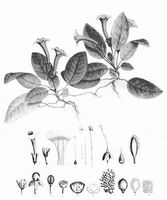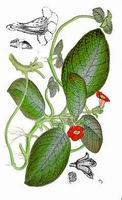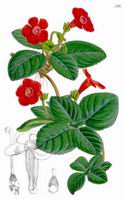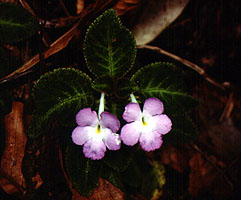
Mart., Nov. gen. sp. pl. 3, t. 217 (1829), original illustration
Full name and orig. publication: Episcia Mart., Nov. gen. sp. pl. 3: 39 (Jan.-June 1829).
Etymology: From the Greek επι, epi = on, upon; and σκια, skia = shadow, in reference to the shady habitat of the plants.
Synonyms: Centrosolenia Benth. (1846), Episcia Mart. sect. Centrosolenia (Benth.) Benth. (1876), Episcia Mart. sect. Episcia subsect. Centrosolenia (Benth.) Leeuwenb., p.p. (1958), Episcia Mart. sect. Episcia subsect. Trematanthera Leeuwenb. (1958), Cyrtodeira Hanst. (1854).
Infrafamilial position: Gesnerioid Gesneriaceae (Gesnerioideae)- Episcieae.
Description: Stoloniferous, terrestrial or saxicolous herbs. Stem creeping, rooting at nodes, dichasially branched by the regular production of stolons. Leaves opposite, the lower pair with axillary stolons, upper pairs crowded, bearing the flowers in their axil; petiole short; lamina without hypodermis; upper surface dark green or with various patterns of variegation, lower surface often colored. Cymes of 1-6 axillary flowers, peduncles slender. Sepals free or shortly connate, upper sepal forced back around the corolla spur, green or colored. Corolla white, yellow, blue, purple or red, inserted horizontally in the calyx, zygomorphic salverform to campanulate, conspicuously spurred, contracted above the spur and at the throat, rarely ventricose, limb oblique, lobes spreading, rounded, entire, their margin minutely toothed or fimbriate. Stamens 4, didynamous, included; filaments nearly straight, inserted at corolla base, after anthesis depressed or coiling; anthers coherent in pairs or in a square, becoming free, dehiscing by a longitudinal slit. Nectary a single large, dorsal gland. Ovary superior; stigma stomatomorphic, bilobed or capitate. Fruit an ovoid bivalved fleshy capsule.
Chromosome number: 2n = 18.
Species number: 9.
Species names (incl. publication and synonyms): See Skog, L.E. & J.K. Boggan. 2005: World checklist of Gesneriaceae: http://persoon.si.edu/Gesneriaceae/Checklist.
Type species: Episcia reptans Mart.
Distribution: From tropical South America to Nicaragua and the Guianas.
Ecology: In tropical forests, in damp places, slopes, banks or rocks, usually at low elevations, partly forming large colonies.
Notes: Episcia has been reduced much in size by the drastic remodelling of the genus by Wiehler (l.c.). Though corolla form is fairly uniform in the species as well in the allied genera Alsobia, Nautilocalyx and Paradrymonia ("episcioid corolla"), coloration suggests pollination by Euglossine bees (e.g., Episcia fimbriata), birds (E. cupreata), and butterflies (E. lilacina).
Selected references: Wiehler, Selbyana 5: 25-28 (1978), emend. & rev.; Skog, Ann. Missouri Bot. Gard. 65: 918-923 (1979), reg. rev. (incl. Alsobia) (Panama); Feuillet & Steyermark, Fl. Venezuel. Guayana 5 (1999), reg. rev.; Skog, Monogr. Syst. Bot. Missouri Bot. Gard. 85: 1114-1128 (2001), reg. rev. (Nicaragua).
Bibliography: See Skog, L.E. & J.K. Boggan. 2005. Bibliography of the Gesneriaceae. 2nd edition: http://persoon.si.edu/Gesneriaceae/Bibliography.
Illustrations:

|
Episcia reptans Mart., type species
Mart., Nov. gen. sp. pl. 3, t. 217 (1829), original illustration |
 |
 |
Episcia cupreata Hanst.
Left: Bot. Mag. t. 4312 (1847) |
 |
Episcia lilacina Hanst. Piedras Blancas N.P., Costa Rica, phot. A. Weber (1999) |
last modified: 2007-01-05